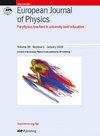多变量微积分教科书对非笛卡尔坐标的表述:多变量微积分教科书内容与高年级物理应用之间的错位
IF 0.8
4区 教育学
Q4 EDUCATION, SCIENTIFIC DISCIPLINES
引用次数: 0
摘要
高年级本科生的物理课程学习需要牢固掌握和流畅运用数学知识,包括了解非笛卡尔坐标(特别是极坐标、球坐标和圆柱坐标)以及如何使用它们。对物理学生坐标系思维的有限研究表明,即使是高年级学生,对坐标系概念的理解也是渐进的。为了更全面地了解高年级物理学生对非笛卡尔坐标的理解,我们研究了七本流行的微积分教科书中的非笛卡尔内容。利用内容分析技术,制定了一个编码方案,以便从定量和定性两个方面深入了解坐标系内容的呈现方式。一个初步发现是,除一本教科书外,其他所有教科书中都没有非笛卡尔基单位矢量。对其中三本微积分教科书的深入分析显示,直角坐标系在教科书内容中占了压倒性的比例,而且从质量上看,直角坐标系是默认的坐标系。定量和定性结果的呈现,以及这些结果可能对中高年级物理教学和研究产生的影响。本文章由计算机程序翻译,如有差异,请以英文原文为准。
Multivariable calculus textbook representation of non-cartesian coordinates: a misalignment between multivariable calculus textbook content and upper-division physics application
Upper-division undergraduate physics coursework necessitates a firm grasp on and fluid use of mathematical knowledge, including an understanding of non-cartesian (specifically polar, spherical and cylindrical) coordinates and how to use them. A limited body of research into physics students’ thinking about coordinate systems suggests that even for upper-division students, understanding of coordinate system concepts is emergent. To more fully grasp upper-division physics students’ incoming understanding of non-cartesian coordinates, the prevalence of non-cartesian content in seven popular Calculus textbooks was studied. Using content analysis techniques, a coding scheme was developed to gain insight into the presentation of coordinate system content both quantitatively and qualitatively. An initial finding was that non-cartesian basis unit vectors were absent in all but one book. A deeper analysis of three of the calculus textbooks showed that cartesian coordinates comprise an overwhelming proportion of the textbooks’ content and that qualitatively the cartesian coordinate system is presented as the default coordinate system. Quantitative and qualitative results are presented with implications for how these results might impact physics teaching and research at the middle and upper-division.
求助全文
通过发布文献求助,成功后即可免费获取论文全文。
去求助
来源期刊

European Journal of Physics
物理-物理:综合
CiteScore
1.70
自引率
28.60%
发文量
128
审稿时长
3-8 weeks
期刊介绍:
European Journal of Physics is a journal of the European Physical Society and its primary mission is to assist in maintaining and improving the standard of taught physics in universities and other institutes of higher education.
Authors submitting articles must indicate the usefulness of their material to physics education and make clear the level of readership (undergraduate or graduate) for which the article is intended. Submissions that omit this information or which, in the publisher''s opinion, do not contribute to the above mission will not be considered for publication.
To this end, we welcome articles that provide original insights and aim to enhance learning in one or more areas of physics. They should normally include at least one of the following:
Explanations of how contemporary research can inform the understanding of physics at university level: for example, a survey of a research field at a level accessible to students, explaining how it illustrates some general principles.
Original insights into the derivation of results. These should be of some general interest, consisting of more than corrections to textbooks.
Descriptions of novel laboratory exercises illustrating new techniques of general interest. Those based on relatively inexpensive equipment are especially welcome.
Articles of a scholarly or reflective nature that are aimed to be of interest to, and at a level appropriate for, physics students or recent graduates.
Descriptions of successful and original student projects, experimental, theoretical or computational.
Discussions of the history, philosophy and epistemology of physics, at a level accessible to physics students and teachers.
Reports of new developments in physics curricula and the techniques for teaching physics.
Physics Education Research reports: articles that provide original experimental and/or theoretical research contributions that directly relate to the teaching and learning of university-level physics.
 求助内容:
求助内容: 应助结果提醒方式:
应助结果提醒方式:


